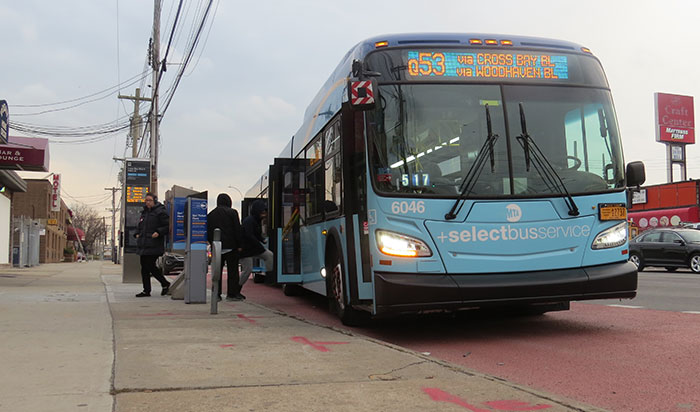File Photo
The City launched the Q52/Q53 Select Bus Service route in November 2017.
By Michael V. Cusenza
Despite the steady chorus of criticism ovDespite the steady chorus of criticism over the last 12 months from long-suffering motorists and small business owners along the Woodhaven-Cross Bay Corridor, the City Department of Transportation has branded the Q52/Q53 Select Bus Service route a success.
The agency said that in the year since the route was introduced, Woodhaven and Cross Bay boulevards have been “transformed” by freshly paved roads with new high-visibility crosswalks, expanded medians and dedicated bus lanes. And the Q52/Q53 SBS status report shows that over last year, bus reliability and travel times have improvedby approximately 10 percent, with ridership and customer satisfaction also rising since Q52/Q53 SBS routes launched on Nov. 12, 2017, bringing improvements like off-board fare payment, median stations and all-door boarding to more than 30,000 daily bus riders from Woodside to the Rockaways. With the addition of safety enhancements, crashes resulting in injuries along the corridor have declined by 6 percent, according to DOT.
“This project was a massive group effort by staff at DOT—as the project combined innovative planning and engineering with extensive repaving, street marking, expanded sidewalk and median work, which have together made buses faster and more reliable,” DOT Commissioner Polly Trottenberg said. “While we were also relieved to see that overall traffic injuries have declined, two recent pedestrian fatalities along Woodhaven prove just how much more Vision Zero work we have to do to make this crash-prone street safer.”
Trottenberg went on to note that those fatalities at the intersection of Woodhaven and Jamaica avenues led DOT to further prioritize the perilous intersection for safety improvements, including: the addition of a pedestrian head-start (also known as leading pedestrian interval, or LPI) to give additional protected crossing time; upgrades to overhead lighting to improve visibility; and installation of flexi-bollards and rubber speed bumps to calm northbound left turns. The intersection is also among the targeted locations for City Police Department enforcement during the ongoing Dusk & Darkness initiative.
In 2019, DOT has pledged to build more pedestrian refuges, extend left turn bays in some locations, add new slips to improve driver access between the main road and service road on Woodhaven Boulevard, and make additional transit improvements along Broadway. Future capital phases of the project will add additional bus bulbs, medians and median tip and sidewalk extensions, street resurfacing and some street reconstruction, Trottenberg added.
The agency also pointed out that the installation of the Woodhaven-Cross Bay SBS route has led to faster and more reliable travel times: 87 percent of riders surveyed say they prefer the Q52/Q53 SBS to the service it replaced, and average weekday ridership is up 5-8 percent. Corridor-wide transit signal priority and other changes to signals, markings and concrete work are all expected to improve travel times further, DOT officials said. And according to agency data, travel times for other vehicles along the corridor stayed the same or only declined modestly.
Anecdotally, drivers who regularly traverse the route have reported longer travel times, ostensibly due to the loss of a thru traffic lane in both directions. And small business owners have brought their complaints of the impact that SBS bus lanes have had on parking, and therefore their bottom lines, to area elected officials.serr
service road on Woodhaven Boulevard, and make additional transit improvements along Broadway. Future capital phases of the project will add additional bus bulbs, medians and median tip and sidewalk extensions, street resurfacing and some street reconstruction, Trottenberg added.
The agency also pointed out that the installation of the Woodhaven-Cross Bay SBS route has led to faster and more reliable travel times: 87 percent of riders surveyed say they prefer the Q52/Q53 SBS to the service it replaced, and average week-
day ridership is up 5-8 percent. Corridor-wide transit signal priority and other changes to signals, markings and concrete work are all expected to improve travel times further, DOT officials said. And according to agency data, travel times for other vehicles along the corridor stayed the same or only declined modestly.
Anecdotally, drivers who regularly traverse the route have reported longer travel times, ostensibly due to the loss of a thru traffic lane in both directions. And small business owners have brought their complaints of the impact that SBS bus lanes have had on parking, and therefore their bottom lines, to area elected officials. oad and ser

